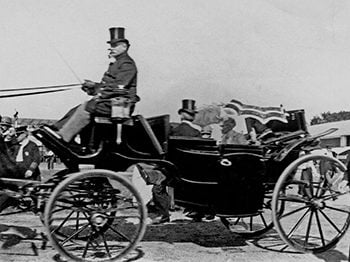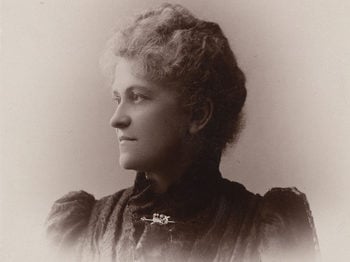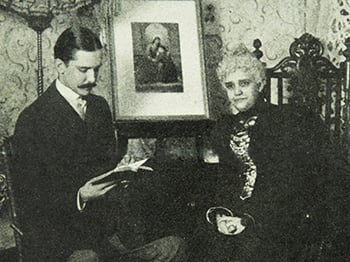“Christian Science unlocked my prison doors,” Laura Lathrop told an audience of thousands who gathered in 1901 to celebrate the opening of Second Church, New York City. “[I]t gave me a God, almighty, omnipotent.”1
Years earlier, Mrs. Lathrop’s life had been hanging by a thread. “Until I came in to the knowledge of Christian Science I never had one well day,” she would write.2
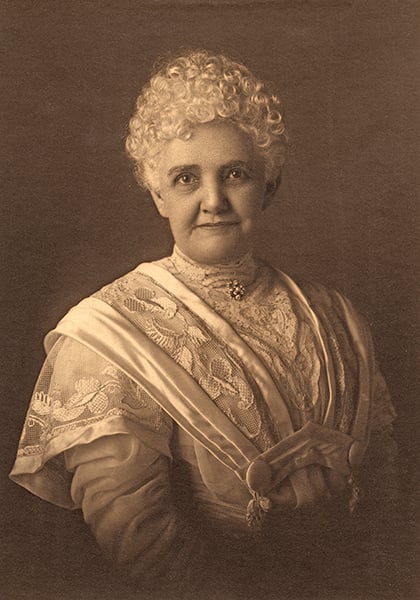
Laura Virginia Best was born in Pennsylvania in 1845 to fervent Methodists. Her father, Charles Best, was a minister and later a Presiding Elder, and her mother, Eliza, “a very spiritually minded woman.”3 Laura, her older brother William, and younger twin siblings James and Caroline, were raised knowing God.4 No matter how many times she read her father’s theological books, however, Laura couldn’t accept her parents’ beliefs.
Her health began to decline at age 17, and a longstanding illness ensued that persisted well into adulthood.
“My life,” she wrote decades later, reflecting on these years, “had been one of intellectual research; my one desire was to know.”5
Laura experimented with various treatments of the day, including homeopathy, allopathy, water-cure, and electricity, but none brought any cure. “I became what is called a chronic invalid; always under a doctor’s care until I was forty years old,” she would write.6
Meanwhile, she married Orvis Christy Lathrop, a lawyer, and had two children, John and Katharine. After Orvis passed on in 1884, Laura’s situation became dire. Her husband had been a wealthy man, but he had lost all of his money prior to his passing. With just fifteen dollars to her name, Laura was now practically penniless and physically helpless, a widow with two children to support.7
“My very trust in God was gone,” she recalls, “my only wish was to die.”8
Bereft of help and without any means to support her family, Laura was at a crossroads. She had heard of Christian Science, but with the nearest practitioner more than a hundred miles away, she and her husband had worried about the effects on Laura’s fragile health that such a trip might bring. Now, as friend after friend wrote urging her to try Christian Science, Laura decided to risk it.
“I had two children, a son and daughter,” she writes, “and it was absolutely necessary for me to get well, so I yielded to the desires of my friends and went to Chicago to be treated by Christian Science.”9
In January 1885, so weak that she had to be carried to and from the train, Laura journeyed from her home in Freeport, Illinois, to Chicago to meet Caroline Noyes, a Christian Science practitioner and teacher.
Christian Science “lifted me out of weakness into strength,” Laura says. “[O]ut of sickness into health, out of gloom into gladness….”10
Following her healing, Mrs. Lathrop remained in Chicago to take Primary class with Mrs. Noyes. It was such a notable event that her local newspaper reported on her trip, noting that she was “studying the science of metaphysics.”11
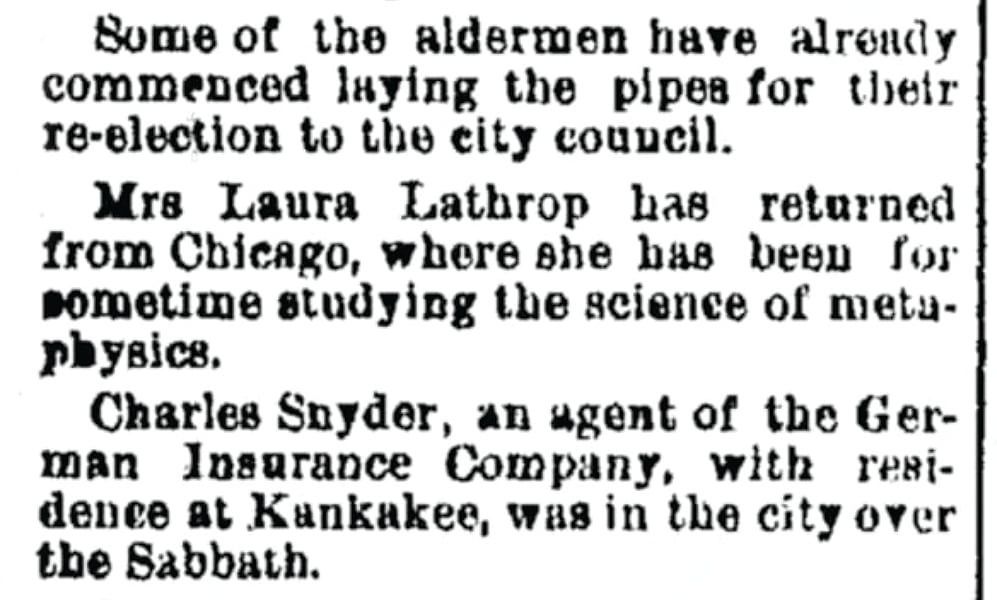
After returning home, Laura immediately began healing others through Christian Science treatment. In August, she sent a letter to Mary Baker Eddy.
“[T]o thoroughly understand the subject,” she wrote, “I must go to you.”12 Mrs. Eddy consented, and in September Laura traveled to Boston to take Primary class at the Massachusetts Metaphysical College.13 Before the last day of the class, she was asked by her teacher to move to New York City and practice healing there.
It was a daunting task. New York City was the largest city in the United States at the time,14 and while there were a handful of Christian Scientists living there, Laura would be heading into a city already rife with growing factions.15 Nevertheless, she was obedient, and courageously moved to New York in October 1885.
“The present generation cannot measure adequately the struggles of the pioneers in the work,” Laura’s friend William McCrackan would later write, “sent out to do unaccustomed things at the request of the Leader, feeling themselves perhaps unsuited by training or lack of education . . . doubting their own abilities, often beset by financial difficulties, frequently misrepresented by friend or foe. . . Nothing but single-minded adherence to the teachings of Christian Science could have brought these persons . . . through these trials to the extraordinary successes which crowned their efforts.”16
The following May, Laura returned to Boston for Normal class with Mrs. Eddy, and a month later she was listed as a teacher in The Christian Science Journal. By September, she had formed a Christian Science institute in New York.17
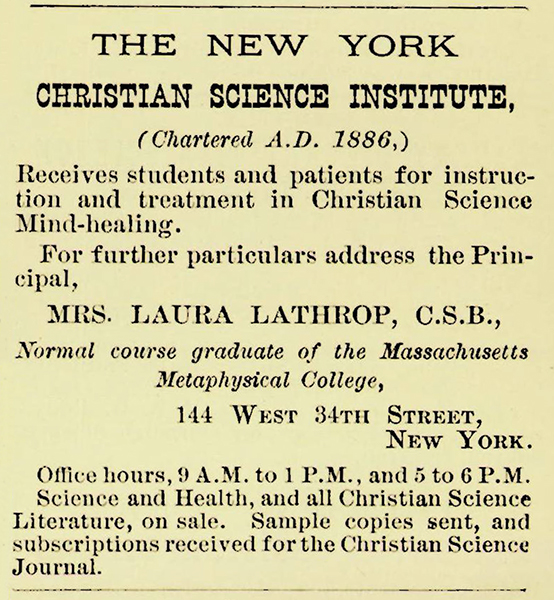
Mrs. Lathrop’s practice continued non-stop. Beginning her day at 8:15 A.M., she gave some 20 treatments before lunchtime, spent the afternoons visiting patients who were unable to leave their homes, and finished the evening with more work in her practitioner’s office.18
Her devotion to the healing work helped spur the growth of Christian Science in the city. When favorable remarks were made about the religion from the pulpit of Bishop John Philip Newman, a well-known Methodist minister and former Chaplain of the United States Senate, a curious press approached Laura to know more.
One reporter offers a vivid description of her at this time: “A tall, graceful figure, fashionably attired . . . a strong, handsome face, with dark, expressive eyes and a crown of hair framing it in curls that showed just the faintest lines of silver among them. . . . Mrs. Lathrop, a highly educated Western woman . . . is not only a charming conversationalist, but a keen and able disputant as well. She is a perfect type of the advanced American.”19
At first, Laura demurred from discussing details about her practice of Christian Science.
“[I]t is considered unprofessional to disclose the names of one’s patients,” she explained, eventually relenting since Mr. Newman himself had raised the issue in his sermon. A few years earlier, she told her visitor, Newman had been scheduled to preach in Brooklyn, but was suffering from laryngitis. A friend persuaded him to consult Laura, and she went to his hotel right away.
“I saw that his voice had gone to a mere whisper,” she recounts. “I sat down there with my bonnet on and gave him treatment.”
Not only was Newman healed, Laura said, but he also developed “a deep interest in the science which he has lately called ‘advanced Christianity.’” He called on her professional services again while she was visiting Washington, D.C., asking her to come to his church, sit in General Ulysses S. Grant’s pew (Newman was a friend of the Grant family), and treat him for an annoying cough that was interrupting his sermons.
“I was somewhat surprised at this request, as you can imagine,” said Laura, “but I was gratified at the confidence in our science shown by this eminent man, and I did as he asked.”
Describing how she diligently treated him during the church service (“I didn’t hear a word he said, from first to last”), Laura notes that Newman thanked her gratefully afterwards.
“I had the best voice I have had in weeks, and the cough never once troubled me during the entire time,” he told her, and invited her back to his study, where he and his wife urged her to teach a class in the capitol.
In 1887, Laura did just that. Other notable members of that class (which included Bishop Newman and his wife) were Susan B. Anthony and the wives of two prominent California industrialists, Mark Hopkins and Leland Stanford.20
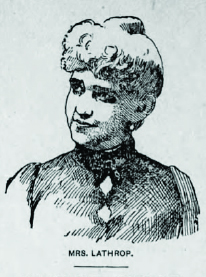
Interest in Christian Science continued to grow rapidly in New York City. In November 1886, Augusta Stetson arrived, followed a year later by Carrie Snider and her husband.21 The three women—all Normal class students of Mrs. Eddy—helped to organize what would later become First Church of Christ, Scientist, New York City, which held its first service on December 4, 1887.
Augusta Stetson was appointed pastor of First Church in 1888 (this was before Mrs. Eddy established the Bible and Science and Health as dual and impersonal pastors in all Christian Science churches). A force to be reckoned with, she held the church in a tight grip, among other things instructing her pupils that she was the only true Christian Science teacher in New York, and the one closest to Mrs. Eddy.22
Laura and others in the New York field were not happy about this, and there was talk of splitting from First Church as early as 1889. Mrs. Eddy, on the other hand, recognized the need for greater unity.23 In a letter written to Laura in 1890, she counseled, “The Principle of our demonstrations as Christian Scientists is Unity and our demonstrations depend on united minds and their at-one-ment with the One Mind.” Her letter continues, “And now dear, sweet child of my heart, will you promise Mother one thing even this. That you will attend the services of the Church of Christ in N.Y. City and pay towards their support whatever you feel able to give? Then when you are ready to take the pulpit yourself, that you will, like Abraham and Lot, part as brethren and establish a church and society of your own in N.Y. City or in any other one that you select.”24
Laura Lathrop took most seriously Mrs. Eddy’s counsel, and when Mrs. Eddy eventually requested her to form a second church in August 1891, her labors quickly bore fruit.25 Two months later, ten Christian Scientists organized Second Church of Christ, Scientist, New York City, and met in a private residence on West 34th Street. Within four years the membership grew to 50, and within nine years to 360. Outgrowing apartments and rented halls, Second Church laid its cornerstone on Easter Sunday, April 2, 1899.26
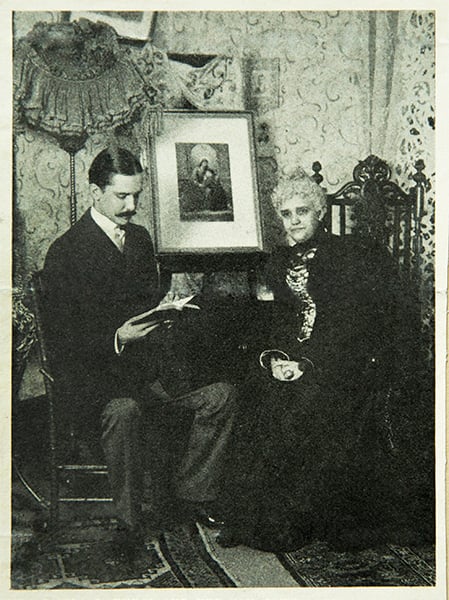
Mrs. Eddy did not attend the opening service of Second Church two years later on Easter Sunday, April 7, 1901, but she did send them a letter: “May the benediction of ‘Well done, good and faithful,’ rest worthily on the builders of this beautiful temple,” she wrote, her letter concluding, “and the glory of the resurrection morn burst upon the spiritual sense of this people with renewed vision, infinite meanings, endless hopes, and glad victories in the onward and upward chain of being.”27
With Laura as First Reader, and her son, John Carroll Lathrop, accompanying her on the platform as Second Reader, the mother-son team made a noteworthy pair. John had joined his mother in New York City in 1886, and following in the footsteps of her example, he became a Christian Science practitioner and teacher, later serving in Mrs. Eddy’s home.28
“Among the brilliant ranks of American teachers—from which might be culled scores of world-renowned men and women—it would be impossible to find another mother and son who occupy the same platform, stand before the same people, and alike devote all their energies to the promulgation of the same truths, both as Christian Science teachers and healers,” Leslie’s Weekly declared. “[T]he sight of this woman and this son inspired a subtle and tender interest, as well as a profound respect for them and for whatever they represent.”29
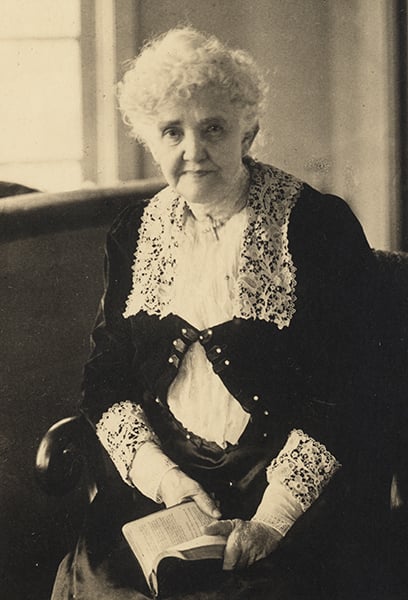
“[A]gainst seemingly tremendous odds, and with the help of God and my Teacher,” Laura Lathrop would write, reflecting back on her many years of hard work, “I succeeded in planting pure Christian Science in the metropolis of the United States.”30
For the closing decade of the 19th century and the opening of the 20th, Laura worked diligently and faithfully in New York. William McCrackan would write of her, “Christian Science found her a confirmed invalid of middle age with no prospect of ever being of any special use in the world, and made of her one of the busiest and most active of women.” He continues, “There are few persons, men or women, among Mrs. Eddy’s students to whom the present generation of Christian Scientists owe as much as they do to Mrs. Lathrop. Her ready smile, her briskness of manner, the charm of her method of setting forth the teachings of Christian Science did much in those early days to show the public that it was a religion of sunshine and joy, entirely separate from the traditional long-faced variety which worships in dim interiors bereft of light.”31
Laura and her son would remain close over the years. After John was appointed First Reader of The Mother Church in 1911, Laura moved with him to Boston, where she continued healing and teaching until her passing in 1922.
